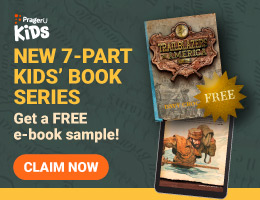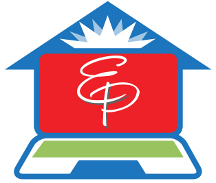Easy Peasy is a free online homeschool curriculum for preschool through high school, generously shared by a homeschooling mom named Lee Giles. This review focuses primarily on the Easy Peasy website with curriculum for preschool through eighth grade. It covers math, language arts, reading, science, history, Bible, music, and art with some additional electives. Giles has created a separate website for high school.
The methodology is an eclectic mix of traditional and "Charlotte Mason" methods. It uses real books, picture studies, copy work, and narration techniques that are generally indicative of Charlotte Mason's methodology, but it also has activity sheets and incorporates other online courses that are more traditionally designed. (I placed "Charlotte Mason" in quotes because there was no purposeful intent to employ Charlotte Mason methods even though some of the methods such as narration and picture studies look like that methodology.)
Courses are presented as online lesson plans with day-by-day instruction. Lesson plans have links to specific lesson material for each day with clear instructions as to where to go and what to do. Linked material is often on other websites, although some is at Easy Peasy. And many lessons include content and activities directly within the lesson plans.
For most courses, you can print any included activity sheets for free as you go through the lessons or print them all at once from a free file. You may also purchase a printed book with activity sheets if you don't want to print out the pages yourself, or if you just prefer having them contained in a book. Aside from a computer or tablet and the printed activity pages, students only need paper, pencils, scissors, glue, and either crayons or colored pencils.
The entire courses for reading, math, and language arts are also available at low cost as offline courses in book form.
You can access all of the online courses for free whether you register or not. Registering gives you access to Easy Peasy's My EP system at no extra cost, although you are given the option to make a donation when you register. This system lets you set up subjects for your student(s) and it keeps track of where students are in all of their lessons. This saves parents and students from having to sort this out every day. My EP does not issue grades or track grading information.
Course questions are generally in the lesson plans rather than on the activity sheets. Answers are often printed in white; highlighting with browser tools makes them appear. Some answers are on password-protected pages. Also, many of the linked websites serve as drill and practice sites. There are no tests that I could find unless they appear in linked websites. Every forty days, children are told to give parents things to add to their portfolio, so parents build a physical record of student work rather than a list of grades from tests. Sometimes a lesson plan will tell the student to take a screenshot of a completed activity that should be put into the portfolio. Of course, parents are welcome to grade student work as they go. A daily progress chart (provided as a PDF file) is a simple chart with one small box for each day—essentially room to check off that a day's lessons were completed.
Students who are independent readers should be able to do much of their work independently, but not all. Younger students will, of course, need much more parental assistance. Even so, this program is very easy for the parent and student to use.
Details for Subjects and Levels
The first two levels are complete readiness courses for preschool and kindergarten levels. Daily lesson plans include links to everything you need to teach math, reading, and language arts. Reading readiness and beginning reading and writing get a lot of attention at these levels.
Giles' approach to reading is a little unusual and worth mentioning. She describes it:
"Phonics is a tool for reading words you don’t recognize. I teach my children the letter names and sounds. Then I teach them to read by sight words. Then I teach them phonics. Phonics is simple at that point because they can already read. All of this takes two years. I do this before they start 'school' so that they can do 'school' more independently and more effectively" (http://allinonehomeschool.com/about/).
She draws heavily on the phonics presentation of Phonics Pathways in the first few years for the phonics. However, because she also teaches sight reading, she expects that children should be able to read McGuffey's First Reader as they start first grade.
After kindergarten level, you can either select a grade-level program that includes math, reading, and language arts in the lesson plans or you can select all courses individually.
English language arts courses in Easy Peasy include spelling, grammar, and composition. Reading, including vocabulary, is taught in separate courses. Real books are built into the curriculum with recommendations mostly coming from the Robinson and Ambleside Online curricula. The required books are available online for free.
The math courses for grades one through five use a wide variety of websites and activities. These include interactive activities on websites, math drills, and games. Easy Peasy has also created four math fact practice books that you can print for free or purchase.
Math for grades five through seven or eight is presented through three courses: Math 5/6, Math 6/7, and Pre-algebra. (These are Easy Peasy courses—not the Saxon Math courses with similar titles.) These courses all use many lessons from other websites such as Khan Academy, Master Math, and MathIsFun. These websites provide practice problems and some quizzes. Students completing these courses should be ready for Algebra 1.
Four Year Cycles for Other Courses
History, science, Bible, music, and art courses are presented in a four-year cycle that allows you to keep all of your children working on the same subject areas each year. These are organized around ancient history, early American history, modern history, and geography. Note that ancient history covers up through the period of exploration.
If you follow Easy Peasy's plan, the first year covers biology, ancient through medieval history, the gospel of Matthew and the historical books of the Bible. In year two, history and science cover early American history and animals, and for Bible, students study the Gospel of Mark, the Acts of the Apostles, and many of the epistles. In the third year, students study earth science, geography, world cultures, and world history (between the Middle Ages and modern times) plus the biblical books of Job, Ecclesiastes, Psalms, Proverbs, and Luke. Year four covers physics and chemistry (both at an elementary level) and twentieth-century history, plus the prophets and the gospel of John for Bible study. Music and art courses are also coordinated with each year.
All of these courses offer separate activities for either grades one through four or for grades five through eight so that assignments are more age appropriate. You will be covering the same topics, but with different material in the lessons. However, you can still use read-aloud books, field trips, and some activities with all ages together. This makes it easy to cycle through the four courses a second time.
Giles rarely interjects her own text into the lesson plans for history and science. However, the first-year courses for history and science both begin with one of these rare interjections as she explains a Christian (young earth) view of early man and of creation and the age of the earth. Year three's Earth Science course also supports a literal interpretation of scripture and a young earth. The curriculum is Christian, but non-Christians can still use it, just skipping the Bible lessons, since the Christian perspective is generally lacking in most internet links.
Electives
The computer and thinking courses for elementary grades are supplemental. They have much less content than a complete course in either of those subjects for one year. Computer learning covers basic operations and the use of various programs and applications at the elementary level. "Thinking" (as Giles labels it) primarily consists of links to logic games.
Introductory Spanish is included in the lesson plans for grades six and seven. Those who want to introduce a different language can use other links provided to find alternative lesson material. Links to sites for foreign languages include options for both younger and older learners. Eighth-grade lesson plans include Spanish 1 lessons that can be used for high school credit.
High School
I haven't reviewed the high school courses, but there are more than enough courses for six credits per year for four years. Core subjects are covered for math, language arts, science, history, and Bible. Math courses go up through calculus and there are five science lab courses. There are four physical education courses and a comparative government course. Still more courses are listed under either "Parent Submitted Courses" or "Links to Other Courses." These include courses for foreign language, economics, computer science, history, and other topics. Many courses are from Georgia Virtual Learning and CK-12, so no textbooks need to be purchased. While Giles has created some of the high school lessons, Easy Peasy fans have contributed others.
Summary
The entire Easy Peasy website is quite impressive. While it isn't a full-service program with record-keeping, you should be able to get help with your questions in a number of ways, again at no cost. First, read the FAQs on the website. Then you might try one of the more than 100 Easy Peasy FaceBook® pages where a core team and more than 100 volunteers are available to help, or you can email.
Sure the curriculum is sometimes uneven, depending upon which sources are being used, but you can always supplement or adapt as needed. Remember that the entire curriculum is free! If you find the Easy Peasy curriculum useful, donation links are on the website.










